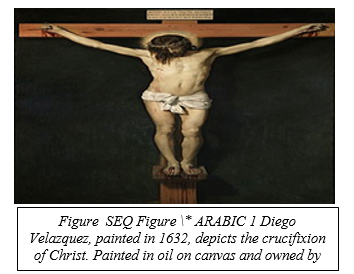Artists inspired to formulate religious arts have proven their crafts to be essential as they increase knowledge of historical and biblical occurrences. The artist uses various textures, colors, and styles to bring history to life, expanding one’s visualization of past circumstances. One of the popular arts in religious paintings is that of the crucifixion of Christ. In the piece of art, the painters use realistic colors to depict Christ’s suffering, humility, and agony, transporting us back to events that occurred two thousand years ago.
An artist referred to as Velazquez carried out the art of the crucifixion of Christ in a creative span. This painting was ideally different from his previous portraits of nudists, such as the Apollo in Vulcan. In this art, he uses the medium of oil painting to represent Jesus on the cross, which initializes that he is dead. Moreover, the art succeeds in formulating work with significant serenity and dignity. Nonetheless, the artist succeeds in imbuing the work with great elegance and poise. The posture of Christ on the cross features feet placed together that is supported by a block of wood, four nails, and arms that form a curve. The head crowing is by thorns, and his face rests on the chest, which enables us to see his configuration. Moreover, his hair lies on the right side, and blood is dripping from the wound on his right side.

The crucifixion art is unusually autobiographical as it outlines Velazquez’s advanced influences. First of all, it recalls the iconography and devotional tone of paintings that were in use in decades in Seville under Francisco Pacheco. Secondly, it reflects the skill Velazquez had learned on figure painting in Italy from classical art and in Spain from the study of the Spanish renaissance. The influence of classism in Velazquez’s art can be traced through the idealized posture of the body of Christ and its calmness. The dramatic tenebrous that focuses all attention on Christ’s pale body shows the influence of Caravaggism.
The painting lacks the characteristics of baroque painting, which reflects in other religious arts, such as descent from the cross or the crucifixion of st Peters. Instead, the artist applies the monumental sculptural quality that enables it to keep the spirituality of the subject. Divinity representation occurs, as the composition is starkly simple; however, there is a difference between the white representation of Christ’s body and the dark background. Moreover, there is naturalism in the way Jesus’ head lies on his chest.
The whole representation of Christ as a divine being on the cross represents his humility and his wiliness to die for us. The paintings preserve religious traditions and make it easier for individuals to speculate certain concepts that could be difficult to explain through words. Moreover, the art speaks to different individuals’ hearts and minds, hence helping nonbelievers adapt to a particular religious belief or culture.